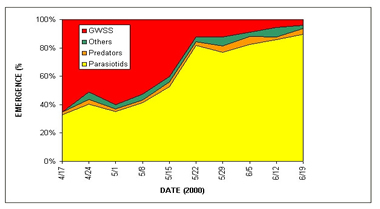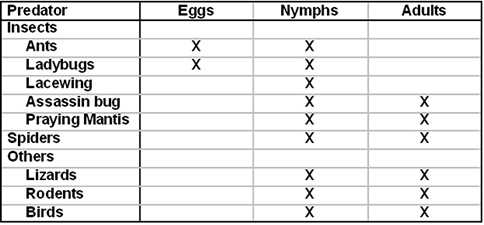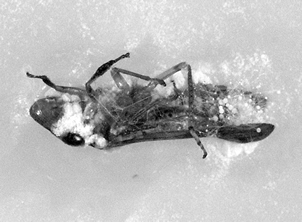GWSS Natural Enemies
A natural enemy is an organism that lives at the expense of another organism and which may limit the population of this organism. Only a few natural enemies are biological control agents; see the biological control section for a discussion on this subject. This section discusses the relative importance of each group of natural enemies with respect to GWSS in California. Natural enemies are generally grouped into three groups:
Parasitoids
Parasitoids are specialized predators; they are insects whose larvae develop by feeding on the bodies of other arthropod hosts resulting in its death. This differs from parasites that no not usually kill their host. The majority of parasitoids are wasps or flies that lay their eggs on or in immature hosts. Once the parasitoid offspring have devoured the host they pupate, emerge, mate, then the females disperse to forage for food and search for hosts to parasitize. Field research on the mortality factors of GWSS in both its native range and its introduced range revealed the most important mortality factors to be parasitoids that attack the egg stage. All organisms found parasitizing the eggs were minute wasps belonging to the families Mymaridae and Trichogrammatidae.

Build up of egg parasitism rates in Temecula organic citrus orchards from April to June.
Over seven species of egg parasitoid are considered as native to California. The primary host of most of these insects prior to the arrival of GWSS in California was the Smoke Tree sharpshooter, Homalodisca liturata. Some of the egg parasitoids are common throughout the GWSS infested range in California, for instance Gonatocerus ashmeadi. Others have a more restricted range; G. morgani has only been found in coastal areas south of Los Angeles while the Trichogrammatidae parasitizing GWSS are confined to the more arid parts of Southern California.
The importance of egg parasitoids as mortality factors of GWSS and other aspects of the natural enemies’ life history make them appropriate for further evaluation as GWSS biological control agents.
No parasitoids that attack nymphal and adult stages of GWSS have been found in California. A dipteran nymphal parasitoid, the bigheaded fly, has been collected in the native range of GWSS and USDA-ARS researchers in Texas are studying the insect’s life history and its possible use as a GWSS biological control agent.
Predators
A number of animals use GWSS as a source of nutrition. These range from insects and spiders through to large predators such as birds, lizards, and rodents. When GWSS first arrived in California, there was little evidence that predators played a important role in the suppression of GWSS populations. After almost 20 years, a number of predators appeared to have moved across to this new source of food and some species are commonly found predating on GWSS. Such findings are based on field observation and monoclonal antibody studies that can identify remains of GWSS in feces and gut contents of predators.
Different predators make use of different GWSS life stages. Egg masses are consumed by ladybugs and ants. Nymphs are predated by lacewing larvae, assassin bugs, and spiders. Adults can be predated by lizards and birds.

The use of predators as biological can be problematic; most predators are generalists in that they feed on a range of prey species. As a result non-target impacts can be significant and difficult to fully evaluate. It is rare for predators to be approved for release into new areas as biological control agents so only a few species that were approved for release are available for use as GWSS biological control agents. Of these, ladybug beetles and lacewing have been investigated as potential biological control agents but no evidence was found that either could suppress GWSS populations. One predator in California has been identified as preying specifically on proconiine sharpshooters, the digger wasp, Pseneo punctatus. Unfortunately, it is not considered suitable as an effective biological control agent as it is univoltine and its nests are vulnerable to predation by ants.
Pathogens
Researchers with the USDA Agricultural Research Service at Shafter (CA), Weslaco (TX), and UC Davis have been screening field collected GWSS from their native range and from California for infection by pathogens. Microorganisms that affect insects include nematodes (e.g. Steinernema spp, Heterorhabditis spp), viral pathogens (e.g. Iridovirus), and fungi (e.g. Metarrhizium spp, Beauvaria bassiana). Many pathogenic isolates have been collected from GWSS and evaluated for their potential as biological control agents. One new species of fungus has been described from these studies.

A fungal entomopathogen (Beauvaria bassiana)
infecting a GWSS adult.
While a number of fungal isolates have been collected from GWSS and described, none have been developed for use as a biological control agent. Common problem with the use of pathogens as biological control agents involve their formulation, delivery, efficacy, specificity, and persistence in the field. Few spray formulations have been successful in California due to the harsh combination of high temperatures, low humidity, and intense ultraviolet radiation found in many of its agroecosystems.

